#caro asercion
Text
This month, we read "i'm sorry did you say street magic", a city-building story game by Caro Asercion.
You can find "i'm sorry did you say street magic" on Caro's itch[dot]io here.
Additionally, we launched a Ko-fi this month! If you're able and want to give us a few dollars, you can find that here.
#i'm sorry did you say street magic#street magic#caro asercion#barclay travis#bee alexander#finch edmund#ttrpgbc#tabletop book club#tabletop games#ttrpgs#indie podcast#podcast#Spotify
63 notes
·
View notes
Note
🌠 or 💡 or both?
💡 A game that inspired my own design or creative practice.
Dwindle by Caro Asercion has been a source of inspiration for me recently! Their game design always stands out to me as gorgeously streamlined: it’s efficient, not in the sense of minimalism or stripping out flavor to leave only mechanics, but in a way that feels respectful of the reader's time.
I could go off about it for ages but the one thing I'll highlight is the way character stats work. I think it's really special when gameplay feels meaningfully in step with the genre and emotional tenor of the game and Dwindle really succeeds there:

ask game to hype other people’s ttrpgs »
60 notes
·
View notes
Text
i’m sorry did you say street magic: A Review
i’m sorry did you say street magic (which does actually have that capitalisation in its title) is what you might tentatively call a ttrpg, but could more accurately be described as a collaborative worldbuilding exercise. A hack of Microscope by Caro Asercion, it guides the table through creating a city and its neighbourhoods, landmarks and residents. This is not a new game by any means, but we played it recently and it was an absolute riot.
Street Magic‘s main selling point is that it enables the players to build a city that none of them would have been able to dream up individually. Our starting set of adjectives was ‘old’, ‘grungey’, ‘mythic’ and ‘science fiction’ and from there we created a city of advanced technology steeped in old traditions, which harvests dreams to power its spaceships, whose governance and economy borders on the dystopic at times and which is the last bastion of civilisation after a mysterious apocolypse destroyed the rest of the universe - and all in about 4 hours.
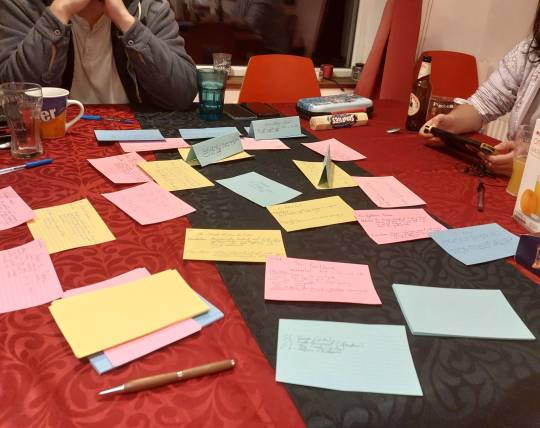
Somnia: The City of Dreams at the End of the Universe
In Street Magic players take it in turns to develop parts of the city through building blocks of increasing specifity. The top level elements of the city are its Neighbourhoods, which contain Landmarks which house Residents. Each round, one player gets to declare a ‘compass’, which is essentially the theme for the round. At the end of a given round, the leading player also dreams up an Event, which will affect one or more of these elements in some way (and which are the tented cards on our table above.)
This system works really well, and is excellent for encouraging players who might not normally worldbuild or GM to take the reigns of creation. It relies heavily on the principles of improv, and works especially well if all the players are willing to take on board the ideas suggested by others. While making a given element, the active player has the final say as to what goes on the little flashcard that represents that element, but after that it is on the table for everyone to interact with as they see fit.
Each ‘element’ - Neighbourhood, Landmark, Resident - has certain aspects that need to be detailed by the players. Street Magic encourages conversation, and the written details are meant to be short reminders rather than verbose descriptions - as the game itself says: what is said is more important than what is written. Consequently, the game also places an emphasis on what it calls ‘liminal cartography’ rather than concrete spatial geography: this is a game about stories and emotional connections rather than lines on a map.
Street Magic excels at enabling the players to map out the emotional and social contours of the city they create, and it’s a lot of fun to watch it grow and spread and to see the story of the urban environment unfold over the course of the play session. The only area where Street Magic falls a little short is in the clarity of its terminology. A Neighbourhood, for example, is required to have a Title, a Reputation and a True Name. A title is its commonplace name (in Somnia we had things like ‘The Factory of Sleep’ and ‘The Garden of Paradise’), while its reputation is broadly what its known for and what the inhabitants of the city think of it. The True Name, though, is the bread-and-butter of Street Magic: it’s the vibe of that place. A True Name should ideally comprise two or three sensory images that capture the essence of the location. In Somnia (yes, we called it that for this joke) our Neighbourhoods had True Names like ‘New Tech Propping up the Old’, ‘Nightmare Fuel’, ‘Blinding’, ‘Anything can be bought or sold’. The True Names can be as detailed as desired but should ideally be short and snappy, and it was a lot of fun trying to boil down complex places into a few words or sentences.
Beyond Neighbourhoods, however, the terminology starts to break down a little. Landmarks have Titles, Addresses and True Names, while Residents only have Titles and True Names. At our table, we kept giving Landmarks reputations even though they don’t technically have them - and eventually we decided to swap out ‘Address’ (which is a vague indicator of where in its attached Neighbourhood a Landmark is) for the same Reputation field that Neighbourhoods have. There doesn’t seem to be a reason why the other two elements can’t use the ‘Title’, ‘Reputation’, ‘True Name’ schema that Neighbourhoods use so well, as it just causes confusion to have each of the three building blocks require different descriptions. Furthermore, ‘True Name’, while being a fun descriptor, can at times be difficult to wrap one’s head around. We generally found it easier to refer to it as the ‘Vibe’ of a given element or its ‘Essence’.
Ultimately, this semantic issue doesn’t spoil the game in the slightest, but at our table it did lead to some confusion. At the end of the day though, it doesn’t really matter: the information on the flashcards is for the benefit of the table, and thus can be whatever you want it to be. If you’re sitting down to play Street Magic, it might be worth considering whether you want to house-rule any of the terms, especially if your players seem confused by the given system after having it explained to them.
To sum up, then, we had a lot of fun with Street Magic, and it offers a very different experience to most ttrpgs. Definitely check it out if you’re looking to do something different with your rpg group - or if you want to give people who normally only play a chance to partake in what is usually the GM’s exclusive activity.
7 notes
·
View notes
Text
Code Green
A game for 3–7 players, about being where you're not supposed to be.
Last night, you were suspended in a tube of brightly coloured goo in an underground research facility, operated by an organisation whose three-letter initialism's meaning is strictly need-to-know.
This morning, someone noticed your tube was empty.
Nobody has determined how that happened yet, and you're not inclined to stick around until they figure it out!
Or, in other words, it's been nearly a whole week since I got that massive revision to Space Gerbils out the door, and apparently my brain has decided that's enough of a break. This thing was written start to finish in under 12 hours, so let the circumstances of its authorship guide your expectations. Special thanks go once again to Caro Asercion, whose micro-RPG Dwindle introduced me to the design space I'm fucking around with here. Go buy their stuff.
Anyway:
What You'll Need
Code Green is a tabletop RPG for one game moderator (GM) and up to six players. Each player will need a copy of the Profile Grid, below, as well as three tokens of some sort: dice, coins, beads, etc. You'll also need at least five six-sided dice (for the whole group, not per player, though it's fine if each player has their own set). If you're using dice for tokens, it's recommended that the dice you plan to roll be visually distinguishable in case they land on someone's Profile Grid.
Rolling Dice
There are two ways you'll be asked to roll dice in this game: rolling d66, and rolling a dice pool.
To roll d66, roll a six-side die twice, reading the first roll as the "tens" place and the second roll as the "ones" place, yielding a number in the range from 11 to 66. For example, if you rolled a 3 and then a 5, your result is 35. You may also be asked to flip a d66 roll; to do this, take your result and swap the digits without re-rolling. In the preceding example, if you flipped your roll of 35, your new result would be 53.
To roll a dice pool, pick up the indicated number of six-side dice, roll them, and take the highest individual result. Duplicates have no special significance. For example, if you rolled a pool of three dice and got a 2, a 4, and a 4, your result would be 4. If you would ever roll a pool of zero or fewer dice, roll two dice and take the lowest instead.
Character Creation
Each player should create their own character. There are three things about your character which are always true:
You are newly born into the world. You may know things about the world (e.g., from your programming, having read them on a computer terminal, etc.), but you haven't experienced them.
You are implausibly good at remaining inconspicuous; unless you're deliberately drawing attention or doing something which requires a dice roll, humans will almost always fail to spot you.
You are not human. You can decide what that means.
To find out what else is true about your character, roll or choose three times from the Form table, and three times from the Function table, placing your results into the correspondingly labelled slots on the Profile Grid, below, in any order you please. Your three results from each table should be different; if you elected to roll and get the same entry multiple times, flip your result, and re-roll if it's still a duplicate.
Think about what your three Form traits and three Function traits imply about your character's physical makeup, but don't set anything in stone just yet – you'll see why not in a moment.
Finally, roll a six-sided die five times, and record the results in the order in which they're received. The resulting five-digit number is the only name your character has when play begins.
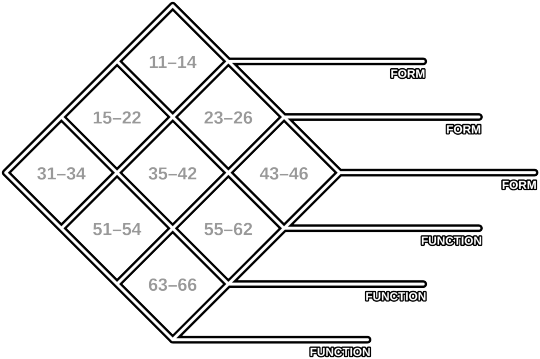
Table 1: Form (d66)
11–12. Blood
13–14. Bones
15–16. Brain
21–22. Claws
23–24. Ears
25–26. Eyes
31–32. Guts
33–34. Hands
35–36. Heart
41–42. Hair
43–44. Legs
45–46. Lungs
51–52. Nose
53–54. Skin
55–56. Tail
61–62. Teeth
63–64. Tongue
65–66. Wings
Table 2: Function (d66)
11–12. Accelerated
13–14. Autonomous
15–16. Auxiliary
21–22. Cryogenic
23–24. Cryptic
25–26. Elastic
31–32. Electric
33–34. Entropic
35–36. Invasive
41–42. Invulnerable
43–44. Kinetic
45–46. Magnetic
51–52. Phasing
53–54. Polymorphic
55–56. Projectile
61–62. Pyrogenic
63–64. Telescopic
65–66. Toxic
Playing the Game
Play proceeds in a series of scenes. In each scene, the GM will set the stage: a challenge to overcome, a peril to escape, a mystery to investigate, etc. Given the nature of your characters, most things will be mysteries to you!
Initial Token Placement
Once the stage has been set, place each of your three tokens on a different square on your Profile Grid. If you have no preference, you can roll d66 for each token and place it in the square whose marked numeric range contains the number you rolled, flipping or re-rolling your result if you get a square which already contains a token. The placement of these tokens represents your initial state when the scene opens. Depending on the nature of your character, this may be reflected by a shifting of internal focus, or by a physical transformation.
Participation
To participate in the scene, simply tell the GM what your character does; the GM will describe how the world responds, and ask what you do next. Whenever you wish – or are forced – to do something more than lurk and observe, you are obliged to make a test.
Making Tests
To make a test, first choose a pair of traits – one Form trait, and one Function trait – with which to face the challenge. For example, if your Form traits are Legs, Tail and Teeth, and your Function traits are Cryptic, Invulnerable and Phasing, you might test your Invulnerable Legs against the trouble at hand.
Next, count the number of tokens present in the rows extending from each of the chosen traits. The illustration below shows which squares would be consulted in the preceding example:
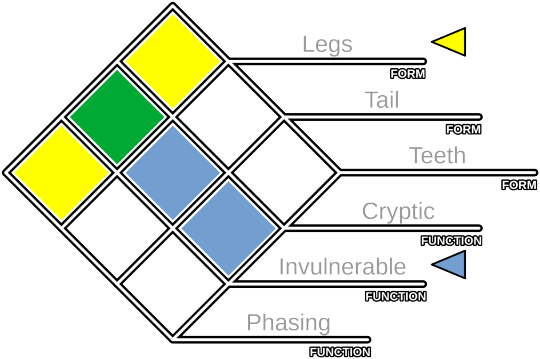
Next, roll a dice pool containing a number of dice equal to the number of tokens present on squares extending from the chosen traits. Do not count a token twice if it's on the square where the two traits intersect (e.g., the green square in the illustration above). In the event that no tokens fall on squares extending from appropriate traits, remember that you are allowed to roll a pool of zero dice by rolling two dice and taking the lowest rather than the highest.
Finally, compare your result to the following table:
1–3. Less than human. Whatever you'd intended to try still happens, but it cannot overcome human opposition (or adversity which would challenge a typical human), and any lasting effects are transitory and easily explained away.
4–5. Mostly human. Your effort can contend with human opposition (or circumstances which would challenge a competent human), and its lasting effects make it obvious that someone (or something) has been interfering with matters.
6. More than human. Your effort easily brushes aside any human opposition, and its lasting effects are impossible to rationalise as anything other than the intervention of inhuman forces.
Without Applicable Traits
In the event that you're forced to make a test and no possible pairing of your traits is applicable, you don't get to roll anything, not even with a pool of zero dice; simply resolve the outcome as though you'd rolled a result of 1–3. Other characters may attempt to preserve you from this fate by assisting you, in which case you roll one die per assisting friend; see below for more details.
Assistance
If you wish to assist another character in making a test, consult your own Profile Grid, considering only those squares which contain tokens. Only the specific pairs of traits represented by the squares on which your tokens fall are eligible for assistance; for example, if one of your tokens falls on the intersection of Cryptic and Teeth, you may assist with Cryptic Teeth, but not any other pair of traits involving Cryptic or Teeth unless those squares also have tokens on them.
If you're able to identify an eligible pair of traits that seems applicable to the test at hand, explain how you're using it to help, and hand the player making the test one extra die. Any number of characters may assist on a given test.
Providing assistance neither requires nor permits your character to adapt (see below) – it needs to be your own test for that!
Adapting
After resolving a test, your character adapts, shifting focus or form to reflect what they've learned. Take one token of your choice from your character sheet, and move it to a different square which doesn't already contain one. You can move any token you wish, but it must end up on a different square than the one it started on unless no valid destinations are available. Adapting is not optional, and must be carried out after every test.
Suffering Strain
If whatever you're making a test against is particularly strenuous or dangerous, you might suffer strain as a consequence. Strain will often be incurred on a result of 1–3, and rarely on a result of 4–5; only the most foolhardy efforts will incur strain even on a result of 6!
To incur strain, roll d66, and place a small X on the square on your Profile Grid whose indicated numeric range contains the number you rolled. If there's a token on that square, immediately move it to an empty square of your choice, unless fewer than three unmarked squares now remain; in that case, simply remove the token entirely.
For the remainder of the scene, tokens may not be moved to any marked square. In addition, if you suffer further strain, and the square indicated by your d66 roll is already marked, your character is incapacitated, and may not participate in tests at all until they recover.
All strain is cleared – and any discarded tokens restored – at the end of each scene. Incapacitated characters also recover at this time.
576 notes
·
View notes
Text
Four musicians. Thirteen dice. One final, desperate shot at immortality.
LAST TRAIN TO BREMEN: A Tragedy for a Doomed Quartet, by @arcnoise , now available on itch
LAST TRAIN TO BREMEN uses snappy mechanics based on Liar's Dice to deliver a grim tale of secrets, backstabbing, and betrayal.
Build your band, flee your cursed contract, and reflect together on all the choices that led you down this sorry path.
213 notes
·
View notes
Text
Everything Is Interstitial: Games inside of Games inside of Games
Interstitial is a game that takes characters and rips them from the cloth of where they come from and quilts them into one world. “Everything is Interstitial” is an extension of that: what if you could do that with mechanics and games?
I have teamed up with 5 designers to bring their games to Interstitial. When you turn the page from one to the other, you will stop being in Interstitial and start being in one of their games. They'll still be playbooks for Interstitial, but you will have the power to get into the gears and change the fabric of how you interact with the base system.
The best way I can put this is like in Dead Cells when you pick up the Hollow Knight needle and suddenly you can incorporate elements of Hollow Knight’s movement and gameplay into the game. I want that for Interstitial. (You can jump on people's heads and swing down, adding parrying and the weird bounce from the HK to a game that does not naturally have it!)

TAKUMA OKADA
Takuma is someone I have known in the TTRPG scene for what feels like ages, and their work has always been deeply impressive to me. They're a creator who has a way of stringing words together that could never come to me, and whenever they release something it feels like it changes the way I think.
You may know them from Stewpot, Alone Among The Stars, and Old Home!
CARO ASERCION
Caro Asercion is someone I could work with every day and not get tired of it. When I read a game by them, it feels like momentum instead of action–their games let you be the movement of the gears, instead of the thing that is forcing them to turn. It feels second nature, and it makes things happen like magic in front of you.
You may know them from i'm sorry, did you say street magic?, Exquisite Biome, and The Long Shift!
TYLER CRUMRINE
Tyler has an absolutely incredible eye for resolution mechanics, and more importantly has a writing that lets me know cleanly and clearly how those mechanics work work cleanly and clearly. I come out of reading those rules like I've always known how to play. The Possible World RPG series is something I carry around with me when I'm traveling, and whenever I show them to people they are amazed and impressed.
You may know them from Beak, Feather, & Bone, Hounds, and Grandpa's Farm!
BRANDON LEON-GAMBETTA
I remember one of my first times ever being on Discord, sitting in the One Shot community, and turning to my wife and going "Oh woah, there's someone in here who actually makes TTRPGs!". That game was Pasión de las Pasiones, and that person was Brandon! I have been following his work forever, and between the experimentation that comes from his podcast or the genre work he's doing in his games, it's always incredible.
You may know him from Pasión de las Pasione, Stop Hack & Roll, and RadCrawl!
BRIAR SOVEREIGN
There is a wealth of big robot games out there in the wild, and to make yours stand out is a feat of strength. Briar's knack for amazing design both in layout and mechanics has made their work resonate clear above everything else. They are an absolute joy to know, and to work with them will be a highlight of my life.

These designers are each going to take one of their games and port it into Interstitial as a playbook, layout and all. This'll give players new mechanics to play around with, and hopefully ways to break everything. All of these designers are incredible at what they do–-- and they're bringing what they do to Interstitial. As long as we can hit that goal!!
73 notes
·
View notes
Text
It's my birthday
and the thing you can do to celebrate is check out Spindlewheel, a tarot-like storytelling system where you weave a story from card to card.
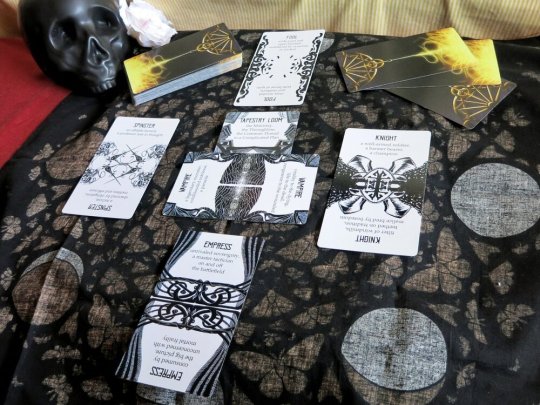
Spindlewheel is a unique system where the deck has as much to say about the story as you do, but the story is bespoke to you and your friends every time. Every Spindlewheel game is a constructed scaffolding for story structure, ranging from western four-act stories in Spindlewheel Classic, to tense bombastic duels to the bitter end in Meet Me In The Field of Honour At Dawn, to sorting out a trio's complicated feelings for each other in Love Machine.
The goal of Spindlewheel is to tell a satisfying story. Your character might win wealth and fame, or they might crash and burn. Both of these are victories if they fit the arc of the story you’ve told, and bring satisfaction to you as a storyteller.
How do you play? Well, I'm glad you asked!
Spindlewheel’s fundamental verb is interpretation.
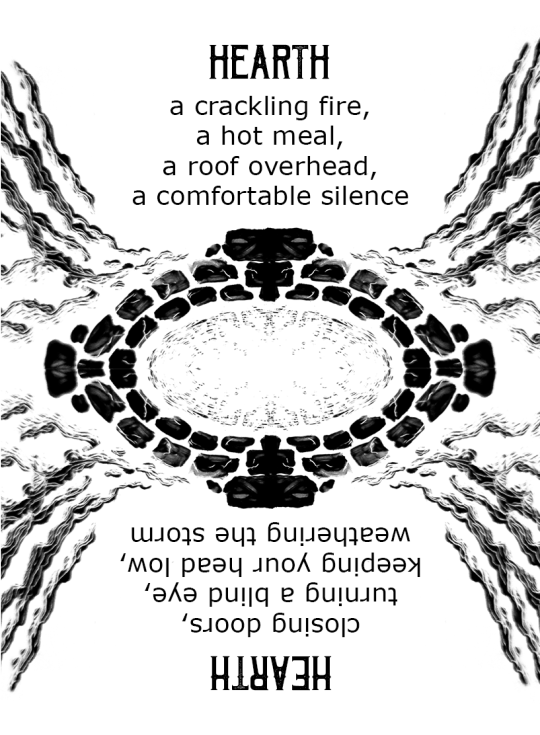
Each card’s text evokes an idea. The upright and inverse text are different. Sometimes they’re diametrically opposed; often, they’re two sides of the same coin.
Use the card as an anchor for the part of the story that you’re telling.
A card can be a person, an event, an attitude, or a physical object.
Use as much as the entire card, or as little as a single word.
A card is interpreted twice: once when it enters your hand, and again when you play it. It does not have to be the same interpretation.
FOR EXAMPLE: I might draw the Hearth card and Reflect that I feel like people closed their doors to me; but I might Engage that card later, declaring I won’t do the same to someone else, and play it to invite someone into my home.

It's a really excellent one shot system: it takes no prep, every setting is procedurally generated for each table, and most games are GMless. The games that are GMed are designed to support improvisation and provide coherent throughlines so the GM can focus on moment to moment play. It also works as a GM tool within other systems for when you need an ominous portent or an answer to a question where a dice roll just won't cut it.
It also makes for pretty damn good radio. Check it out on Party of One, An Atlas of the World Unknown, You Don't Meet In An Inn, Follow the Leader, and played extensively in the devlog Spindlewheel Stories where you can listen as the game takes shape over time.
Did I mention it's got an open SRD? Anyone can hack the system and sell their games. Here's a collection of people who have done just that!
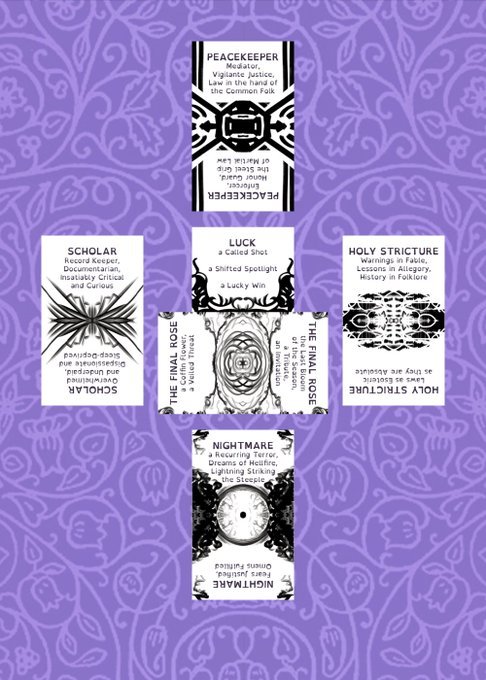
Curious?
There's lots of ways to try Spindlewheel online for free! give @spindlewheelbot (by Caro Asercion) on twitter an @ for a "classic" spread inspired by the celtic cross, or a single card "vibe check"; print and play the deck with the original legacy art or play it on playingcards.io; or play it on Tabletop Playground and Tabletop Simulator.
Convinced?
Head over to www.teacabbage.com/spindlewheel to pick your digital copy of Spindlewheel on itch.io and roll20!
#spindlewheel#indie ttrpg#tabletop#tarot#gmless#been meaning to make this post for a while#sorry my whole life is wrapped up in this game if you're tired of hearing about it but also: it's a good game so idc
326 notes
·
View notes
Link
From the creator of “I’m sorry did you say street magic,” Dwindle is an occult cyberpunk game set in a virtual city, once a hub of technology and activity, now abandoned by its creators. Surrounded by crumbling infrastructure and ancient, glitchy coding, you struggle to survive and save what you can of the city and people you love.
Dwindle is gm-optional, so you can have a traditional gm or play gm-less fairly easily. Character creation is quick and easy, with a few questions to answer and examples/options of answers provided. The mechanics are interesting, d6-based on a grid/dice pool (a handy online grid is provided that does your rolls for you). Keeping with the themes of fading and rebuilding in spite of it, you can “dwindle” by using up your dice as you roll until you have less and less dice–but rolling a 1, although a failure, allows you to replenish your dice fully and even gives you the opportunity to change your stat distribution.
Mod Note: I liked this game though my main critique WAS that it was too simple. But if you’re fine with that, its really good :)
41 notes
·
View notes
Text

[Image ID: A white and red banner whose title says “Indie Bundle For Abortion Funds” in red text against a white background. Additional white text against a red background beneath the title says “750+ Works,” “600+ Creators,” “$3000+ Value,” “$10 Minimum Cost,” “All Proceeds Donated.” End ID.]
In light of the U.S. Supreme Court’s decision to overturn Roe v. Wade and threaten and remove access to abortions, creators from all across itch.io have contributed projects to this solidarity bundle.
100% of the proceeds from this bundle will go to the National Network for Abortion Fund's Collective Power Fund, which moves money directly to abortion funds across 20+ U.S. states, with a particular focus on the South and Midwest (where it is often most difficult to get access to abortions). NNAF’s partnerships with these abortion funds provide direct resources and funds to many of the people most impacted by Roe v. Wade, towards immediate action.
Hey yall! Caro Asercion, a trans multiracial game designer and artist, is hosting an indie game bundle of 792 games to donate money to abortion rights. The whole bundle can be bought for just $10. As of now, about 50% of the bundle’s goal of $400,000.00 has been reached.
Link to the bundle’s itch.io page
Link to Caro’s original twitter post announcing the bundle
The bundle will run live through July 13th!!
451 notes
·
View notes
Text
THEME: Map-Making Games
This week's games are centred around map-making or city-building games.








The Quiet Year by Avery Alder.
The Quiet Year is a map game. You define the struggles of a community living after the collapse of civilization, and attempt to build something good within their quiet year. Every decision and every action is set against a backdrop of dwindling time and rising concern.
This game uses a deck of cards and a map that the group will communally elaborate upon, picking up characters and elements of the setting to answer questions as the game goes on. You will play through four seasons, and at some point in Winter, the game will suddenly end.
If you like this idea, but would like to play from the perspective of monsters putting their lives back together before the Humans come back, you should try The Deep Forest, by Avery Alder and Mark Diaz Truman.
The Shrike, by sadpress.
It is early evening aboard the airship The Shrike. Far below us, rich pine forests roll past. It is fine flying weather, and the skies around us, for now, are empty. Soon pale miniature cliffs slip away beneath, and now we are over the vast dark sea. The sun's glow on the horizon fades. One by one the stars come out, but they fail to illuminate the waves below. We are hurtling in the quiet darkness. We put on our lanterns. Our voyage has begun.
The Shrike is a game about fantastical voyages aboard a skyship. It's inspired by Avery Alder's The Quiet Year, John Harper's Lady Blackbird, Italo Calvino, Ursula K. Le Guin, and utopian and dystopian fiction. It features four complete adventures (two multiplayer, two for solo play).
Adventures for The Shrike provide a level of detail between traditional game-books and oracle-based games such as The Quiet Year. You'll encounter people, places, and other prompts, but you'll also have the flexibility to build your own world and tell your own stories.
If you are interested in this game, you might also be interested in The Shrike Voyage Generator (which is still in alpha!
Cul-de-sac, by Clint Smith.
Cul-de-sac is a neighbourhood-building RPG exploring the connections, or lack thereof, between people living in close proximity. Players collaboratively create the occupants of a neighbourhood, what their lives are like, and what secrets they hold.
This game uses Tarot cards, with the Minor Arcana representing the everyday occurrences of the neighbourhood, while the Major Arcana represents significant events. The Neighbourhood centres on the families of the neighbourhood, and you will spend 12 turns exploring the personalities of the Cul-de-sac. Each turn has two phases: the Day Phase and the Night Phase. The Day Phase tells us about new events; the Night Phase tells us about the cult-de-sac’s personalities.
This game is a very interpretive game; it’s also simple and pay-what-you-want. It’s inspired by games such as the Quiet Year, and I’m sorry did you say street magic, which, as you might have guessed, have had a big impact on map-making games in the indie scene.
The Station, by pidj
The Station is a GMless worldbuilding game where players take turn answering prompts about a train, a station and the people. The Station explores how places shape people and people shape places in the vein of i'm sorry did you say street magic by Caro Asercion and The Quiet Year, by Avery Alder.
The Station uses no dice. It uses playing cards, paper (such as index cards) and points. The game is A6, fully illustrated and laid-out, and is 16 pages long. Play time is adjusted by setting the number of Train Progress cards required to begin resolution or by changing the size of the deck. Draw cards and answer questions to build a world. The prompts are genre-agnostic and you will have plenty of opportunities to ask your own questions of the table. When your time is up, collaborate to bring the game to a close in a bitter-sweet resolution. Spend points to resolve the stories of some of the characters you have collaborated on and bring your time together to a close.
If you like the quiet everyday magic of Studio Ghibli movies, this might be the game for you. The artwork carries a mix of whims and mundanity, and the game is set up so that everyone has some level of creative control.
What the Water Gave Us by JordannaGeorge
What the Water Gave Us is collaborative storytelling game about strange things that come out of the water, and how the community deals with it.
This game also uses a deck of cards, and players will take turns drawing cards and answering questions about what exactly is coming out of the water - and whether or not it turns out to be a blessing or a curse. The game plays out over the course of a four seasons, with the option to continue playing after the first year if you feel like you haven't fully fleshed out the narrative yet. It's simple to set up, with an easy oracle to get you started. If you're looking to tell a story specifically about seaside or lakeside towns, or if you like stories about the mysterious and unknown, this might be the game for you.
Questlandia (Second Edition) by turtlebun.
In Questlandia, you and your friends will invent a world from scratch. It might be fantastic or bizarre, from a remembered past or imagined future. You’ll paint a picture of your society and its people, their laws and customs, how they live and how they dream.
But your society is failing.
As you play, your characters will attempt to find beauty and purpose amidst the chaos of a changing world.
Questlandia is a tabletop roleplaying game that creates fantastical worlds in states of change. It may be medieval fantasy in a ghost-haunted kingdom, neo-noir in a roboticized undercity, or microscopic slipstream suburbia in a puddle.
The concept of Questlandia is beautiful and enchanting, and it lends itself to new and exciting worlds in which you can play using the same system, or re-visit with a game of your choice. The second edition uses a deck of cards as well as d6s: cards to build the world, d6's to explore the conflict that is befalling your beloved world.
The first edition of Questlandia is $2 cheaper, and can be found here.
An Altogether Different River by ehronlime.
It has been some time since you’ve left home, but now it’s finally time to return. To what, though?
The home you held in your mind, and the home you will encounter will not be the same. You are not the same.You can’t step into the same river twice. You can’t go home again.
This is a GM-less roleplaying game meant for 2 to 4 players and a single session of about 3-4 hours. It is inspired in parts by Downfall, by Caroline Hobbs and Microscope, by Ben Robbins. It is about a Town, the people who have left it and returned, and the people who stayed behind.
This is a game that is just as much about a town as it is about the people who live in it. It explores themes of change and growth, and the feeling you get when you go back to a town that isn't really home anymore. At the end of the game, you'll likely have questions unanswered, so if you like finishing games with a bit of bittersweetness, you might want to try this one out.
An archipelago-based fishing town, separated by its various islands, gathers annually to celebrate the turn of the harvest.
A collective of magical artists embarks on an ambitious project: a guerrilla public transit system powered by enchanted street art.
In a sprawling metropolis decades from now, breakthroughs in biotechnology offer citizens superpowers far beyond mortal ability.
This city that we call home has a magic all its own. It is wonder, and joy, and spirit — and with that spirit, we breathe life into our city together.
i'm sorry did you say street magic is a GMless city-building story game for two to six players, that runs three or more hours. Discover and imagine a city filled with life and vivid detail, packed with a myriad of neighborhoods, landmarks, and residents. Discover their true names, and the ways that they intersect—then set events in motion that will change or alter their relationships.
This is an enchanting game, with the breadth you need for any city, whether it be fantastical, futuristic, or modern-day. You can mix and match with different themes, and each player has a chance to imbue the city with their own personal touch. At the end of every round, one player instigates an event that will certainly stir up excitement, but wil usually won't be resolved by the time the game is over. If you're looking at establishing a setting for a game with distinct city sectors and characters that act as emblems for a larger neighbourhood, if you want a game that hands a series of story hooks over to the GM by the time you've finished, this is absolutely the game for you.
The author has also written a supplement that you can use to generate true names if you want some inspiration. It is called there are names more powerful here than our own.
173 notes
·
View notes
Text
Tabletop Book Club has a Ko-fi now. Is anybody talking about this?? [From our March episode about “i’m sorry did you say street magic” by Caro Asercion.]
8 notes
·
View notes
Note
TTRPG ask game: 🌠 (mechanic u love)
I love mechanics that have you interact with or change materials, like how you light a match and maybe light paper on fire in Caro Asercion's 'The Incendiaries': https://seaexcursion.itch.io/the-incendiaries
Thanks for the ask!
23 notes
·
View notes
Text
The readers of the Indie RPG newsletter are building a city together!


So for those who don't know, the Indie RPG Newsletter is a weekly newsletter that tries to share the most interesting stuff happening in indie tabletop roleplaying games. Recently, there's been a lot of talk about daily writing exercises. The designer of Mothership proposed writing one room every day for 2023 so you ended up with this one massive megadungeon!
To me, daily writing exercises are cool but they're also A LOT. So I was thinking about a weekly writing challenge for myself. I love cities so I was thinking about writing a city. And then I was thinking about low-effort ways for many people to contribute to the same city. And, well, maybe Goncharov being in the air and all, I thought about what about using the newsletter to play a city-building game with my readers.
There are about 2700 readers of the newsletter so this could get messy. I needed some kind of framework so I decided to use i'm sorry did you say street magic by caro asercion. And Caro sweetly gave me permission to do that!
So we've finished with the setup phase, readers have submitted their adjectives to inspire the city (stratified, clockwork, canaled) and we have voted on a name - Immoria!.
So what is Immoria?
Imagine that when people say time is a river, they mean it literally. Imagine the river of time was routed into canals that spread through a great city. Imagine this city as tall, built upon layers and layers of different communities and neighbourhoods. Imagine these canals entered the city at the very top and then slipped and flowed all the way down through the city’s many layers until it escaped and found its way into the sea of chaos. The river of time brings odd gifts and sometimes even odder things wash up on the shores of chaos. Some say the city is a giant water clock. But people who live there just call it home.
In i'm sorry did you say street magic, you build out a city by adding neighbourhoods, landmarks and people. Landmarks are always within a neighbourhood and people are always within a landmark. Readers have already started adding neighbourhoods. We've got Brasspool, Tangent, The Eddies, and so on. I'm organizing all of them on this site here. It's going to be the public archive of sorts.
Last week, we started the first proper round of the game. Every round starts with a compass - which gives you a direction or theme for the round. So when you add landmarks or people, you try to stick to that theme.
People have submitted their compass suggestions and I'm going to announce one in the next issue. If you'd like to play and help build Immoria or just follow along, check out the newsletter!
ttrpg.substack.com/
83 notes
·
View notes
Text
ohhhh itch.io is doing another huge charity bundle it goes to the national network of abortion fund's collective power fund this time!!
theres more info on the page, but a couple games in it are hypnospace outlaw, catlateral damage, and calico! there's also a ton of tabletop games in there if youre into those
EDIT: this bundle is over now! they made 384k!!!
166 notes
·
View notes
Text
i know people are loathe to try podcast recommendations from strangers on the internet, but please, you have to listen to The Wandering Path
it JUST started releasing, but i've been fortunate enough to hear the first 5 epsiodes and i've genuinely never listened to an actual play where the table has such insane chemistry with one another- i think a lot of the time in actual plays, it feels like the players just kind of...tolerate any time when the spotlight isn't on their pc? but this group is palpably invested in the other characters at the table, and you can feel the joy they have about one another's characters, and the world itself
so far there are just 2 worldbuilding episodes based on a hack of caro asercion's "i'm sorry did you say street magic", and episode 1, which released yesterday
truly, if you think you might like a new actual play in your life, you have to at least give the preview a shot
(Also, if you ever listened to Ars Paradoxica or StarTripper!!, it's created, edited, and DM'd by the same person who made those, Mischa Stanton)
(Also also, if you ever liked the things @bext-k has been in, they're a player and producer on the show!!)
#The Wandering Path#ars paradoxica#bex taylor-klaus#actual play#i'm sorry did you say street magic#podcast#podcasts
3 notes
·
View notes
Text
youtube
My latest review is out! I talked about Caro Asercion’s “Exquisite Biome,” and the ways in which it uses the tried-and-true method of deck-based prompts to build plausible and weird animals! As a big fan of Spore, I loved what Asercion did with this game, and I highly recommend you take a look.
57 notes
·
View notes